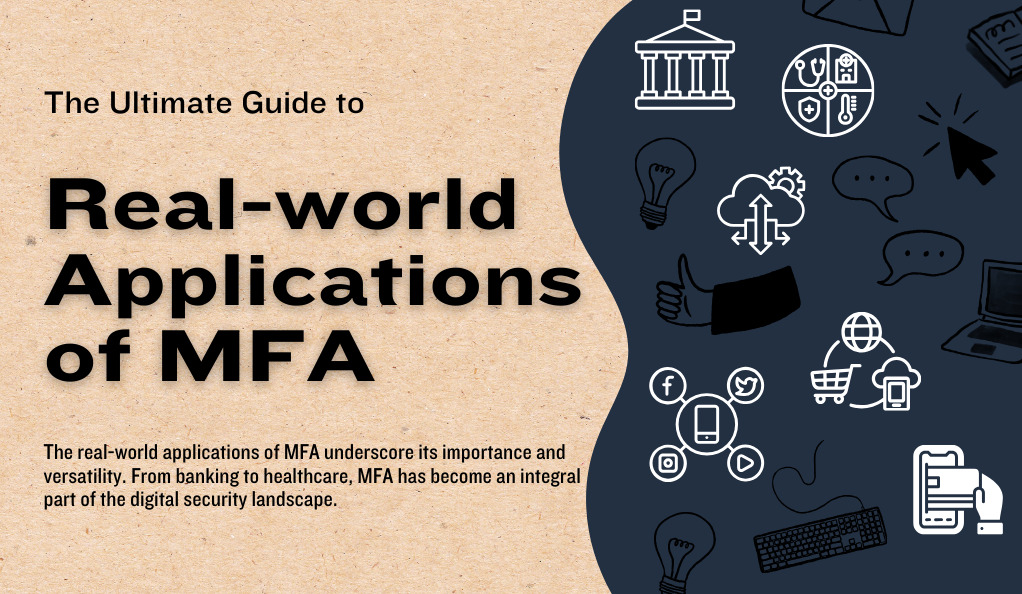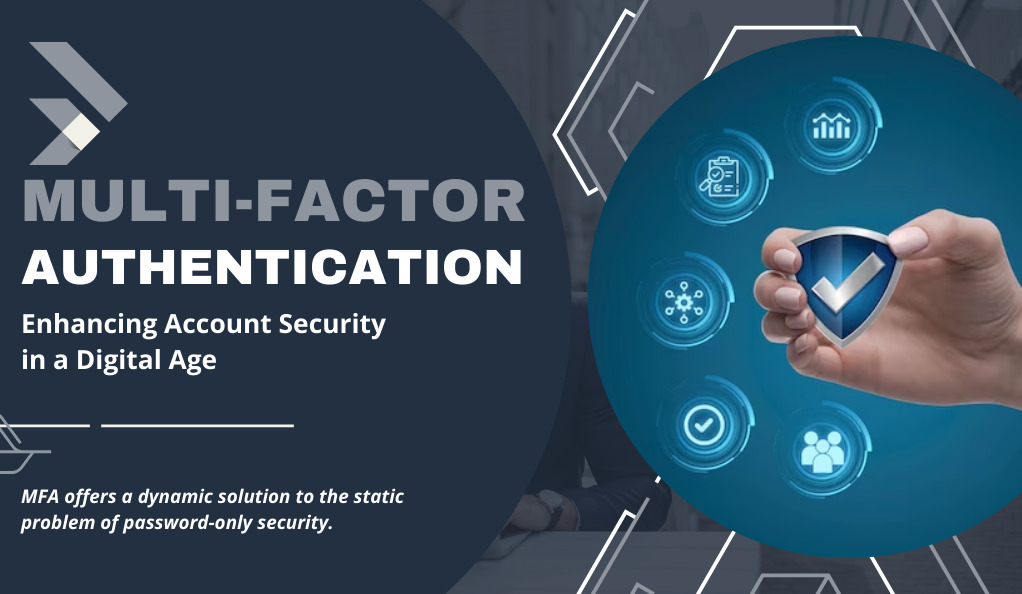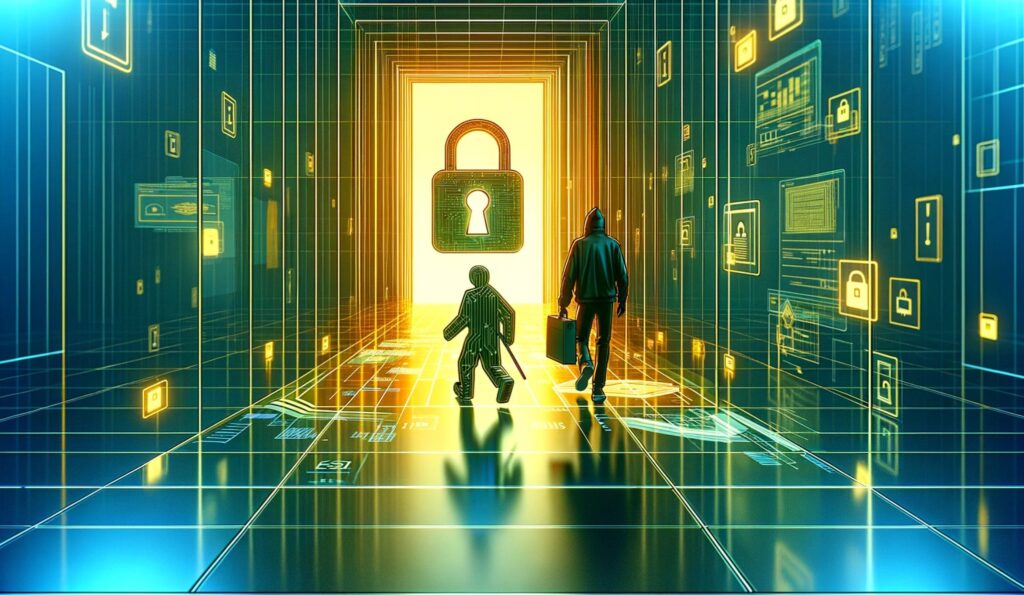In today’s digital age, where cyber threats loom large and data breaches are a constant concern, securing online accounts and sensitive information has never been more crucial. Enter Multi-Factor Authentication (MFA) – a robust security measure designed to provide an additional layer of protection beyond just a username and password.
What is Multi-Factor Authentication (MFA)?

At its core, MFA is an electronic authentication method that requires users to provide two or more verification factors to gain access to a resource such as an application, online account, or a VPN. Instead of just asking for a username and password, MFA requires additional credentials. These could be something the user knows (like a password or PIN), something the user has (like a smart card or a mobile device), or something the user is (like a fingerprint or voice pattern).
Why is MFA Important in the Digital Age?
With the increasing number of online platforms and services, users often resort to reusing passwords across multiple sites. If one of these platforms is compromised, all accounts with the reused password are at risk. MFA acts as a second line of defense. Even if malicious actors obtain a user’s password, they would still need the second verification factor, making unauthorized access significantly more challenging.
Two-factor vs. Multi-factor Authentication:
While the terms are sometimes used interchangeably, there’s a subtle difference between two-factor (2FA) and multi-factor authentication. 2FA is a subset of MFA. While 2FA requires two types of identification, MFA could involve two or more. For instance, accessing a secure vault might require a password, a fingerprint, and a retinal scan – that’s MFA with three verification factors.
| Type | Description | Examples |
|---|---|---|
| Something the user knows | Knowledge-based factors | Password, PIN, security questions |
| Something the user has | Possession-based factors | Smart card, mobile device, security token |
| Something the user is | Inherence-based factors | Fingerprint, voice pattern, retinal scan |
The Mechanics of MFA
Understanding the intricacies of Multi-Factor Authentication requires a deep dive into its mechanics. Let’s explore how MFA operates and the pivotal role of third-party authenticator apps in this process.
How Does MFA Work?
When a user attempts to access a secured resource, they are first prompted to enter their primary credentials, usually a username and password. Once these are verified, the MFA process begins. The system prompts the user for an additional verification factor. The exact nature of this prompt depends on the type of MFA in place. It could be a text message sent to a registered mobile number, a push notification from an authenticator app, or even a biometric prompt like a fingerprint scan.
The user must successfully provide this second (or third, or fourth) factor to gain access. If they fail to do so within a specified time frame, access is denied. This multi-layered approach ensures that even if one verification method is compromised, malicious actors can’t gain access without the other factors.
Role of Third-Party Authenticator Apps
With the rise of MFA, several third-party authenticator apps have emerged to facilitate the process. These apps, such as Google Authenticator, Authy, and Microsoft Authenticator, generate time-sensitive codes that users must input as their second factor. Here’s how they work:
- Setup: The user links their account with the authenticator app, usually by scanning a QR code.
- Code Generation: The app generates a unique, time-sensitive code every 30 seconds or so.
- User Input: When prompted by the MFA system, the user opens the app, views the current code, and inputs it into the system.
- Verification: The system verifies the code. If it matches and is within the valid time frame, access is granted.
These apps offer several advantages. They work even without an internet connection, as the code generation is based on a pre-shared secret and the current time. They also eliminate the risk associated with SMS-based MFA, where codes can be intercepted or redirected.
Inherent Challenges
While MFA adds a robust layer of security, it’s not without challenges. Users might find it cumbersome to always provide multiple factors, leading to “MFA fatigue.” There’s also the risk of losing access to the secondary factor, like misplacing a security token or changing a phone number without updating the MFA settings.
Factors in Authentication
The strength of Multi-Factor Authentication (MFA) lies in its diverse range of verification factors. By understanding these factors, we can appreciate the depth and breadth of security MFA offers. Let’s delve into the three primary categories of authentication factors.
1. Something the User Knows: Knowledge-Based Factors
These are the most traditional forms of authentication and include:
- Passwords: A secret combination of characters known only to the user and the system.
- PINs (Personal Identification Numbers): Typically a numerical code used in conjunction with bank cards or mobile devices.
- Security Questions: Pre-set questions that only the user should know the answer to, such as “What was the name of your first pet?”
While knowledge-based factors are familiar and widely used, they are also the most susceptible to attacks, such as phishing or brute force attempts. Hence, relying solely on them is no longer considered sufficiently secure in many contexts.
2. Something the User Has: Possession-Based Factors
This category involves physical items or devices that a user must possess to authenticate:
- Smart Cards: Physical cards with embedded chips that store authentication data.
- Security Tokens: Devices that generate time-sensitive codes for authentication.
- Mobile Devices: Smartphones or tablets that can receive SMS codes or use authenticator apps.
The advantage of possession-based factors is that even if a malicious actor knows a user’s password, they can’t access the account without the physical device. However, there’s the challenge of device loss or theft.
3. Something the User Is: Inherence-Based Factors
These are biometric methods of authentication, relying on unique physical or behavioral attributes:
- Fingerprint Scans: Uses the unique patterns of a user’s fingerprint for verification.
- Voice Recognition: Analyzes a user’s voice pattern to confirm their identity.
- Retinal or Iris Scans: Uses the unique patterns in a user’s eye for authentication.
- Facial Recognition: Analyzes facial features to verify a user’s identity.
Biometric factors offer a high level of security since they are inherently unique to each individual. However, they come with privacy concerns and potential challenges in accuracy and false negatives.
Balancing Factors for Optimal Security
The key to effective MFA is balancing these factors based on the security needs of a particular system or application. For instance, a banking app might require both a password and a fingerprint scan, ensuring that even if a password is compromised, unauthorized access is still prevented by the need for a biometric match.
Real-world Applications of MFA

The beauty of Multi-Factor Authentication (MFA) is not just in its theoretical strength but in its practical applications. Across various sectors and platforms, MFA has proven to be a game-changer, enhancing security and trust. Let’s explore some of these real-world applications.
Online Banking and Financial Transactions: Financial institutions have always been prime targets for cybercriminals. With the rise of online banking, the need for enhanced security became paramount. Many banks now require customers to use MFA when accessing their accounts, especially for high-value transactions. This might involve receiving an SMS code, using a hardware token, or even providing a biometric verification.
E-commerce Platforms: Online shopping platforms store a wealth of user data, from personal details to credit card information. To protect users from potential fraud, many e-commerce sites have implemented MFA, especially during the checkout process or when changing account details.
Cloud Services and Data Storage: As businesses migrate to the cloud, securing sensitive data becomes crucial. Cloud service providers often offer MFA as an additional layer of security, ensuring that only authorized personnel can access certain data repositories or administrative functions.
Social Media and Email Platforms: Given the personal and sometimes professional information stored on social media and email platforms, many of these services have introduced MFA to prevent unauthorized access. This is especially vital if a user’s password gets exposed in a data breach.
Healthcare Systems: Patient data is both sensitive and valuable. Healthcare systems and electronic health record platforms are increasingly adopting MFA to ensure that only authorized medical professionals can access patient records, thereby safeguarding privacy and complying with regulations like HIPAA.
Work Environments and Remote Access: With the rise of remote work, companies need to ensure that their networks and systems remain secure. MFA is often used when employees log in to company systems from external locations, ensuring that the person accessing the system is indeed the authorized employee.
Government and Public Services: Government databases hold a vast amount of sensitive information. To prevent data breaches and unauthorized access, many government portals and services have implemented MFA, especially for services related to personal identification, taxation, and benefits.
Challenges and Vulnerabilities
While Multi-Factor Authentication (MFA) offers a robust layer of security, it’s not without its challenges and potential vulnerabilities. Understanding these issues is crucial for both users and organizations to maximize the benefits of MFA while being aware of its limitations.
Phishing Attacks
Even with MFA in place, phishing remains a significant threat. Sophisticated attackers can create fake login pages that not only capture usernames and passwords but also prompt users for their MFA codes. Once provided, attackers can quickly use these codes to access accounts in real-time.
Man-in-the-Browser and Man-in-the-Middle Attacks
These types of attacks involve intercepting communication between the user and the authenticating server. Attackers can potentially capture MFA tokens or manipulate the authentication process, gaining unauthorized access.
MFA Fatigue
As more platforms adopt MFA, users might experience “MFA fatigue,” finding it cumbersome to always provide multiple factors of authentication. This could lead to users opting out of MFA where it’s optional or using less secure methods.
Device Loss or Change
If MFA relies on a device (like a smartphone for SMS codes or an authenticator app), losing that device can lock users out of their accounts. Similarly, changing phone numbers without updating MFA settings can lead to access issues.
Biometric False Negatives
While biometrics offer a high level of security, they’re not foolproof. Factors like dirty sensors, injuries, or even changes in voice can lead to false negatives, preventing legitimate users from accessing their accounts.
Reliance on Third-Party Authenticator Apps
While third-party authenticator apps enhance MFA’s security, they also introduce another point of potential failure. If the app experiences downtime or issues, users might be unable to access their accounts.
Backup Methods and Account Recovery
Organizations need to strike a balance between security and usability. If a user can’t access their primary MFA method, there should be backup options. However, these backup methods can introduce vulnerabilities if not properly secured.
Mobile Phone-Based Authentication
In the realm of Multi-Factor Authentication (MFA), mobile phones have emerged as a popular and convenient tool for verification. Their ubiquity and the range of technologies they support make them a natural fit for enhancing security. However, like all methods, mobile phone-based authentication has its advantages and challenges.
Advantages of Mobile Phone-Based Authentication
- Ubiquity: Most people own a mobile phone, making it a readily available tool for authentication without the need for additional hardware.
- Convenience: Receiving an SMS code or using an authenticator app is often quicker and more straightforward than other methods, such as entering a password from a physical token.
- Diverse Methods: Mobile phones support a range of authentication methods, from SMS codes and push notifications to biometrics like fingerprint and facial recognition.
- Dynamic Codes: Authenticator apps generate time-sensitive codes, adding an extra layer of security as the code changes frequently.
Disadvantages and Concerns
- SMS Interception: SMS-based codes can be vulnerable to interception, either through malicious software on the phone or via network vulnerabilities.
- Phone Loss or Theft: If a phone is lost or stolen, an attacker might gain access to MFA codes, especially if the phone is not secured with a password or biometric.
- SIM Swapping: A sophisticated attack where a malicious actor convinces a mobile carrier to switch a user’s phone number to a new SIM card, giving the attacker access to SMS-based MFA codes.
- Reliance on Network: In areas with poor network coverage, receiving SMS codes might be delayed or impossible.
Best Practices for Mobile Phone-Based Authentication
- Use Authenticator Apps: Where possible, use authenticator apps instead of SMS codes. They’re generally more secure and don’t rely on network coverage.
- Secure Your Phone: Always use a strong password, PIN, or biometric to lock your phone. Regularly update your phone’s software to protect against vulnerabilities.
- Be Wary of Phishing Attempts: Be cautious of any unsolicited messages or calls asking for MFA codes.
- Regularly Review Account Activity: Regularly check the activity on accounts protected by MFA to spot any unauthorized access.
Legislation and Regulation Surrounding MFA

As the digital landscape evolves, so too does the regulatory environment. Governments and international bodies recognize the importance of robust cybersecurity, and Multi-Factor Authentication (MFA) has become a focal point in many regulatory frameworks. Let’s explore the legislation and regulations that shape the use and implementation of MFA.
General Data Protection Regulation (GDPR)
The European Union’s GDPR, which came into effect in 2018, emphasizes the protection of personal data. While it doesn’t mandate MFA explicitly, it does require organizations to implement appropriate security measures. Given the recognized effectiveness of MFA, many organizations have adopted it as part of their GDPR compliance strategy.
Payment Card Industry Data Security Standard (PCI DSS)
For businesses that handle credit card transactions, PCI DSS sets the security standards. One of its requirements is that entities use MFA for all remote network access originating from outside the network.
Health Insurance Portability and Accountability Act (HIPAA)
In the U.S., healthcare providers that handle electronic health records must comply with HIPAA. While MFA isn’t explicitly required, the act mandates adequate safeguards to ensure data confidentiality and integrity. As a result, many healthcare organizations have turned to MFA as a means to bolster their security.
Federal Financial Institutions Examination Council (FFIEC)
The FFIEC’s guidelines recommend financial institutions use MFA, especially for high-risk transactions. This has led many banks and financial entities to adopt MFA as a standard practice.
California Consumer Privacy Act (CCPA)
While the CCPA focuses on consumer data rights, it also requires businesses to implement reasonable security procedures. Given the known vulnerabilities of single-factor authentication, many interpret “reasonable security” to include MFA.
NIST Guidelines
The U.S. National Institute of Standards and Technology (NIST) provides guidelines on digital identity and authentication. Recent updates to these guidelines have moved away from SMS-based MFA due to potential vulnerabilities, emphasizing more secure methods.
The Future of MFA
The future of Multi-Factor Authentication (MFA) is poised for dynamic evolution, driven by technological advancements and the ever-shifting landscape of cyber threats. From the rise of adaptive authentication, which tailors verification challenges based on risk profiles, to the integration of behavioral biometrics and AI-driven mechanisms, MFA is set to become more sophisticated and user-centric. As the digital realm expands, encompassing everything from personal devices to vast IoT ecosystems, MFA will remain at the forefront, continuously adapting and innovating to offer robust security solutions in an increasingly interconnected world.
Conclusion
In the ever-evolving digital landscape, Multi-Factor Authentication (MFA) stands as a paramount defense mechanism, safeguarding data and accounts from potential breaches. Its adaptability, spanning from traditional passwords to advanced biometrics, underscores its significance in a world where cyber threats are omnipresent and ever-growing.
As we integrate more digital platforms into our daily lives, the role of MFA becomes increasingly crucial. It’s not just about security; it’s about ensuring trust, reliability, and peace of mind in our interactions within the digital realm. The challenges are many, but with vigilance and innovation, MFA remains our steadfast ally against cyber threats.








